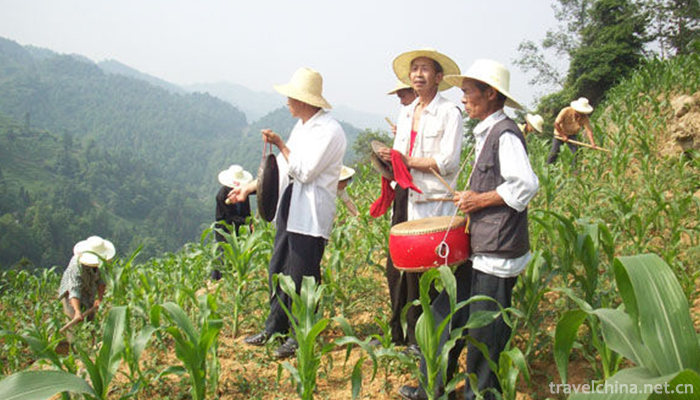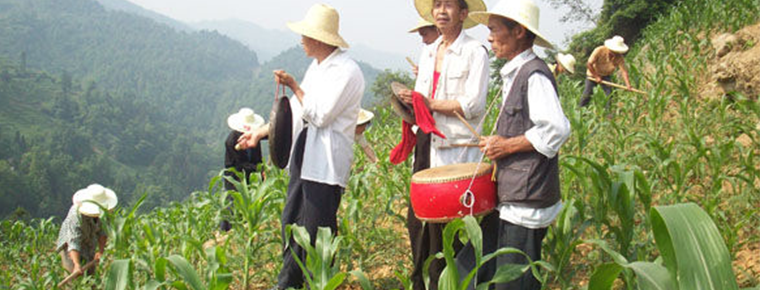Caogao Gong and drum in northern Sichuan
Caogao Gong and drum in northern Sichuan
Licao Gong and drum in northern Sichuan is a kind of traditional folk music. It mainly distributes in four counties and three districts of Guangyuan City, Sichuan Province, among which Qingchuan Grass Drum is the most representative. Grass drum is a kind of traditional folk culture widely spread in the northern mountainous areas of Sichuan Province. It is commonly known as "playing Gong and drum grass", "playing Gong and drum grass", "banishing Gong and drum grass". In July and August of each year, people usually sing a folk song when they weed corn grass and soybean grass together. Grass gongs and drums can not only ensure the progress and quality of weeding, but also make heavy manual labor easy in laughter, so that workers can fully enjoy the pleasure and happiness of labor.
On May 20, 2006, the dragon and drum in northern Sichuan were listed in the first batch of national intangible cultural heritage list with the approval of the State Council.
historical origin
Qingchuan County is located in the northern mountainous areas of Sichuan Basin, the junction of Sichuan, Gansu and Shaanxi provinces, known as the "home of giant pandas". Qingchuan grass gongs and drums are distributed in 36 villages and towns in the county. The grass gongs and drums in Banqiao Township, Daba Township, Qingxi Township, Sanguo Township, Debris Township and Maoba Township are the most distinctive.
artistic characteristics
Rich content
In July and August of each year, when weeding corn grass and soybean grass, several or dozens of households of labor force gather together, one person beats gongs, one person beats drums, while beating rhythmically singing, to inspire the morale of workers, unify the pace, eliminate fatigue. The gongs and drums are mostly local knowledgeable, prestigious old people or young people with cultivation prospects. The gongs are called "song Lang" and the drummers are called "joining hands" and "going the same way".
The process of a day can be roughly divided into: pulling strings, putting a lid (starting or choreographing), Anwufang (or worshipping Wufang), speaking the text, playing songs, and handing over. At about eight o'clock in the morning, when the Gong sounded, people were told that it was time to go out. Gongshou walking in front, the rest of the people heard the sound followed, gradually connected into a line in the mountain path, commonly known as "lead line". Arriving at the farming destination, the singer begins with a song and opens with a high-pitched voice in the accompaniment of gongs and drums. Next is "An Wufang". Some singers worship the five gods of east, west, north and south, while others worship heaven, earth and people directly. They pay attention to "time, place, people and people".
It takes up most of the day's work to speak the text. The content of the lyrics includes not only the compiled albums, but also the seven-character or cross written in a fixed format, which is spread orally among the people. In the special red age, Mao Zedong's seven laws and seven unique poems, Guo Moruo's seven-character poems have become the main content of the lyrics. In labor, if someone is found to be behind the times, the singer will come behind him and beat the gong and drum vigorously, encouraging and urging the outdated to catch up. The singer sings loudly and passionately, the laborer weeds quickly, and you chase after me, presenting a lively scene of drum music, song and laughter. Grass gongs and drums can not only ensure the progress and quality of weeding, but also make heavy manual labor easy in laughter, so that workers can fully enjoy the pleasure and happiness of labor.
Various forms
There are seven, nine, twelve and flower beats in the rhythm of cymbals and drums. Melodies and lyrics are divided into seven-character notation and cross notation according to the number of words. In addition, there are many kinds of tunes such as five-character notation and traditional lyrics and improvisational lyrics imparted orally. Singing works mainly include "Han Xiangzhuan", "Eight Immortals Tu", "Nautilus" and "Qingguantu", as well as some folk songs such as "Two-sided Willow Leaves" and "March Baicao Qing".
North Sichuan is rich in content, honest and plain singing and playing methods, with a long history of inheritance, and more than 10,000 oral lyrics. Its tunes are concise and lively, unique and highly appealing, which greatly enriches the cultural life of the people in the deep mountains. Protecting and inheriting the grass gongs and drums in northern Sichuan will certainly enrich and improve the Chinese folk music culture.
Representative works
Biography of Han Xiangzhuan, Eight Immortals Tu, Nautilus Ji, Qingguantu, etc.
Inheritance significance
"Grass Drum in North Sichuan" integrates folk culture and music into hard work. It is the crystallization of the wisdom of the working people in the mountain areas of North Sichuan, and it is also the precious cultural heritage left by the sages of past dynasties. Grass gongs and drums in northern Sichuan are an important part of folk culture in mountain areas of northern Sichuan, and are also excellent folk music culture left over by ancient sages. In the field work, the grass gongs and drums in northern Sichuan play the role of directing labor, activating the atmosphere on the spot and regulating the mood of the laborers. It has a straightforward and simple music personality, rich reserves of thousands of pieces of music, bright and concise vocabulary of music retains a large number of ancient physical labor in the music and cultural information, has a high academic research value.
Nowadays, due to the influence of modern production mode, the traditional production and lifestyle can hardly keep pace with the development of the times. The living space of the grass gongs and drums in northern Sichuan is shrinking day by day, and they are in danger of being lost. Old singers have passed away one after another, young people go out to work, a large number of labor migration, and the singer team is green and yellow. Therefore, the work of protecting and inheriting the grass gongs and drums in northern Sichuan has reached a critical moment.
The state attaches great importance to the protection of intangible cultural heritage. On May 20, 2006, the grass gongs and drums in northern Sichuan were approved by the State Council and listed in the first batch of national intangible cultural heritage lists.


-
1.Shennongjia Forestry DistrictHubei Shennongjia
Shennongjia Forest District, referred to as Shennongjia for short, was established in 1970 with the approval of the State Council and directly under the jurisdiction of Hubei Province.
Time 2018-10-28 -
2.Shuimogou Scenic Area
Shuimogou Scenic Area, also known as Shuimogou Park, is named after Shuimogou in the scenic area. It is located in the eastern suburb of Urumqi, Xinjiang. Around 2000
Time 2019-02-13 -
3.Yao Wan ancient town
Yaowan Ancient Town is located in the southwest edge of Xinyi City, Xuzhou City, Jiangsu Province, at the junction of Beijing-Hangzhou Grand Canal and Luoma Lake, and is connected with Suqian, Suining
Time 2019-03-03 -
4.Eight Delicacies Rice
The traditional name of Ningbo is Laba Festival Food. It is made from raw materials such as glutinous rice, bean paste, jujube paste, preserved fruit, lotus seed, rice kernel, longan, sugar and pig fa
Time 2019-03-25 -
5.Bru
Bru, Mongolian means throwing. Competitions are divided into two categories: long throw and accurate throw, mostly held in festive festivals. The long throw is to decide
Time 2019-04-04 -
6.Jiangxi opera
Gan Opera is a traditional opera which sings high-pitched, random-play, Kun Opera and other tunes in a multi-tone way. The dialect used is Gan dialect. Its origin and predecessor
Time 2019-04-30 -
7.Quanzhou North Pipe
Beiguan, also known as Beiqu, Xiaoqu, Quzi, is a kind of traditional folk silk and bamboo music widely spread in Quangang District, Quanzhou City, Fujian Province. China's Beiguan is now only distribu
Time 2019-06-11 -
8.Youyang Ancient Songs
Youyang Ancient Songs are the words chanted or chanted by sorcerers in the activities of ancestor worship, praying for high yield, exorcising evil spirits and returning vows. The Youyang Tujia and Mia
Time 2019-07-14 -
9.Make a chant
Bamboo and hemp trumpet is a traditional folk song of Qionglai City, Sichuan Province. It belongs to a kind of labor trumpet sung by local papermaking workers when playing bamboo and hemp. It is mainl
Time 2019-08-03 -
10.Hong Xiuquan
Hong Xiuquan (January 1, 1814 - June 1, 1864) was famous for his show. In order to avoid God's "Huo Huo Hua", Jehovah "Homonym" has been changed to the present name, the founder of
Time 2019-09-07 -
11.Longmenshan earthquake site park
This entry is lack of information column, supplement the relevant content to make the entry more complete, but also can quickly upgrade, come on! The site earthquake park includes the widely spread ruins of Xiaoyudong bridge
Time 2020-11-05 -
12.Convenient facilities and medical services of Chengdu Giant Panda Base
Chengdu Research Base of giant panda breeding has a tourist service center in the hall on the first floor of the museum, which can provide free convenience services such as microwave heating, drinking water hot water, baby carriage, wheelchair, walking stick, umbrella, needle and thread bag, etc.
Time 2020-12-13